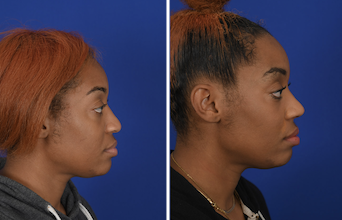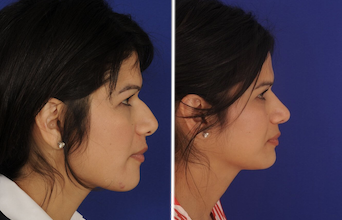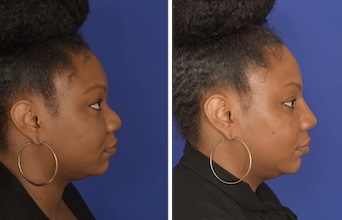Ethnic Rhinoplasty
Premier Houston Rhinoplasty Surgeon Dr. Michel Siegel

People of all backgrounds may want nose surgery. Given that the facial features and anatomy vary between people of different ethnicities, so does the surgical process on your specific nose. Techniques that work well for a Caucasian nose may be ineffective when reshaping the nose of an Black, Asian, Latino, or Middle Eastern patient. (For more info on this, read our page on “What Patients of Different Ethnic Backgrounds Want to Change About Their Noses.”) Wherever your nose is in relation to where you want it to be, Houston’s Dr. Michel Siegel can help.
Dr. Siegel’s experience in “ethnic” rhinoplasty has helped him understand the specific anatomical differences between patients’ unique backgrounds, and tailor his surgical approach to deliver balanced, harmonious, natural-looking results.
Note: Dr. Siegel specializes in preservation and ultrasonic rhinoplasty, both of which produce superior results. He is one of the few surgeons in the US experienced in these types of rhinoplasty. Find out more.
Dr. Siegel Understands Your Goals and the Balance You’re Going for
As an experienced nose surgeon who listens to his patients’ needs and goals before making them a reality, Dr. Siegel has a good sense of the nuanced, occasionally conflicting goals you might have for your nose and overall look. For more about that, you can check out our page titled “What Patients of Different Ethnic Backgrounds Want to Change About Their Noses,” but here is a quick summary of what we think you might have in mind:
What Black & African American patients often want out of nose surgery: Many Black patients want smaller nostrils, a more-refined tip, and a nasal bridge that is less flat. At the same time, they do not want a “Michael Jackson” nose: one that’s too small, too obviously worked on, and too white-looking. It needs to be balanced, and part of that means preserving a look that is true to their heritage.
What Asian patients often want out of nose surgery: Asian patients often want a higher and more-defined nose bridge, narrower nostrils, and a tip that’s more refined and less bulbous. Their biggest concern overall tends to be achieving more definition, typically by making the tip of the nose less round and making the nostrils somewhat smaller.
What Indian and Middle Eastern patients often want out of nose surgery: Patients of Middle Eastern, Indian, descent typically would like to remove a hump and have a straighter (less sloping) bridge, and refine and lift a droopy tip. They want the tip lifted only slightly, so that it appears basically straight from the side, and not lifted UP. In the same way, they want to avoid a nose that appears too thin or pinched (with no nostril showing). In general, Indian and Middle Eastern patients want conservative changes and a light touch, so that nobody – even people in their community – can tell they had surgery.
What Latino patients often want out of nose surgery: With a Latina / Latino patient the goal tends to be pretty straightforward: a smaller nose. If a hump is present, they want a gentler slope or curve. Many want a refined and somewhat lifted tip.
What Patients Say
Hollie Nguyen
Jhanae Kelley
Madeylon Minguell
Garrin Chillis
Lorena Lissette
Avani Persaud
Dave Grygier
Sirena Ramirez
Adrian Walker
Ethnic Rhinoplasty Before & After



You Are an Individual.
So is Our Process.
No matter what your ethnic background is, Dr. Siegel will guide you through the entire process and will focus on creating an outstanding, yet harmonious result that enhances your appearance. Despite his vast experience, he has no “formula” for nose surgery: your rhinoplasty is tailored to you and your unique needs.
Beyond your ethnic background are your individual facial features. A successful rhinoplasty has the following benefits:
- Improves balance between your facial features.
- Honors your background, rather than tries to ignore, bury, or muddle it.
- Increases your confidence in you appearance
- Improves breathing function (if you have snoring or breathing problems).

Why choose Dr. Michel Siegel for your rhinoplasty?
The success of your nose surgery depends above all on the nose surgeon you pick.
Rhinoplasty is not just another procedure offered by Dr. Siegel: It is his main focus. Dr. Siegel is a nose surgery specialist. He is double board certified by the only two boards certifying nose specialists (abohns.org and abfprs.org. Those certifications and his 20+ years of rhinoplasty experience, allow him to perform revision rhinoplasty to correct flaws in primary, secondary, and tertiary rhinoplasties.
More developments in rhinoplasty surgery have occurred in the last 15 years than in the previous 100. Your surgeon should be skilled in the best new techniques in nose surgery.
Dr. Siegel is one of the first surgeons in Texas and the country to be trained in Turkey, Europe, and Latin America in advanced surgical techniques for nose surgery. These techniques include ultrasonic rhinoplasty, which avoids breaking the bones as in traditional rhinoplasty, and preservation rhinoplasty, where the shape of the nose is changed by "preserving" the supportive structures of the nose with minimal bone and cartilage removal. This leads to faster healing and natural long-term outcomes in a shorter period.
Rhinoplasty is more than just a surgical procedure. It is a series of personal decisions, followed by a series of medical and aesthetic decisions. Dr. Siegel will work with you every step of the way. You will not be handed off to an assistant or a junior associate. We remain a small boutique practice providing not only exceptional surgical results and personalized care.
Find out even more about why to choose Dr. Siegel, or contact us to discuss your perfect look.
What is the Ethnic Rhinoplasty process?
If you are considering nose surgery, it is important that you understand every aspect of the process. It involves several steps:
1
Consultation
If you’re interested in nose surgery that works for you and your unique background, you’ll begin with an initial consultation at our office in Houston. During that appointment, Dr. Siegel will evaluate your individual case, answer any questions, and listen to your personal vision regarding how you would like your newly-shaped nose to appear. He will also perform a detailed exam to gain a deeper knowledge of your individual nasal structure. This will allow Dr. Siegel to fully draw up a customized surgical plan to achieve a balanced, harmonious outcome that enhances your appearance, yet maintains your ethnic identity.
To help you better understand what to expect from your ethnic rhinoplasty in Houston, he will also show you a three-dimensional “before and after.” There are no limits on the time needed for your consultation: Dr. Siegel will discuss the procedure with you until you are completely confident and ready to move forward.
2
Preparation
Since each ethnic rhinoplasty is unique, your pre- and post-operative instructions may vary depending on the customized surgical plan Dr. Siegel has designed for you. We will provide you with guidelines to follow so you are fully prepared for surgery. Dr. Siegel will go over everything you need to know and do from the week before your rhinoplasty through full recovery. While the pre and post-surgical directions may vary, there are some general rules for any surgery, including staying hydrated and avoiding taking medications that pose a risk of increased bleeding or could interact with anesthesia.
3
Rhinoplasty Procedure
Your rhinoplasty will be carried out in our safe and fully-certified Houston cosmetic surgery facility. Since each procedure is unique, the time it takes to complete your procedure will vary according to what needs to be accomplished in altering your nose structure. For example, if you have a deviated septum, Dr. Siegel may combine your rhinoplasty with a septoplasty to repair this health issue, which may require additional time.
4
Recovering
Because Dr. Siegel has extensive experience and expertise, with a practice exclusive to facial plastic surgery, most patients find that the recovery from ethnic rhinoplasty is far quicker and easier than they anticipated. Dr. Siegel doesn’t use any internal packing or gauze after surgery, avoiding the traditional pain and pressure associated with recovering from nose surgery. Instead, an external splint will be worn on the bridge of the nose for five to seven days after surgery. Most patients are comfortable returning to work or other activities in about one week.
Dr. Siegel’s expertise and vast experience in rhinoplasty give him the ability to handle the nose tissues using an extra-delicate approach, so his patients rarely experience the traditional black and blue bruising around the eyes associated with rhinoplasty. Successful results depend not only on the surgery itself, but on the aftercare. Follow-up appointments may be needed periodically after your surgery date.
Frequently Asked Questions
Question:
What Are the Most Common Concerns Resolved with an African American Rhinoplasty?
Answer:
Most often, patients seeking African American rhinoplasty are interested in having a narrower, better-defined nasal tip, a thinner nasal bridge, and narrowing nostril structure, although everyone is different.
There are many techniques to narrow nose size and create a more refined look. Dr. Siegel’s approach allows for a seamless incision placement, for virtually “scar-free” results. He understands that many African-American patients are at a higher risk of developing keloids, or fibrous scar tissue. Luckily, the nose is one area in which keloids do not form.
Question:
What Are the Most Common Concerns Resolved with a Latino Rhinoplasty?
Answer:
Hispanic and Latino patients have a wide variety of nose shapes and sizes, so the concerns Dr. Siegel addresses with this type of ethnic rhinoplasty will vary widely. Some Latino patients may want to improve the appearance of a flat bridge, which gives the nose a broader appearance.
Dr. Siegel can address this concern by using a graft (typically of cartilage) to add subtle height and structure, giving the illusion of a narrower nose. Patients with wider, rounded nostrils may benefit from re-sculpting the nostril tissue. Some Latino patients may want more clearly defined tips to their noses, which can may involve grafting and the construction of nose tip support. When you come for a consultation, Dr. Siegel will talk through your concerns with you and create a customized Latino rhinoplasty plan to create the look that will best enhance your other attractive facial features.
Question:
What is the Recovery Time After Ethnic Rhinoplasty?
Answer:
You may have searched online and seen patients with black and blue bruising around the eyes, and horror stories about recovery from the procedure. The meticulous surgical approach employed by Dr. Siegel means your recovery will be faster, with less damage to surrounding tissues with limited bruising. Most people are completely comfortable returning to work in a week.
Question:
At What Age Can You Get an Ethnic Rhinoplasty?
Answer:
To undergo nose surgery, the nose should have reached its full growth. For girls, this is typically about age 14, and for boys, a bit later.
Question:
What Anesthesia is Used in Performing Rhinoplasty?
To protect the breathing structures, in most cases, general anesthesia is the preferred way for performing rhinoplasty. This allows for safer surgery and a faster recovery.
Question:
How Long Will an Ethnic Rhinoplasty Take?
Answer:
Each person has a unique facial structure, including the nose. Predicting the length of the surgery is difficult unless a full, in-person evaluation is performed, along with discussing your vision for a new nose structure. Depending upon what needs to be altered, the surgery may take from between one and three hours.
Question:
Where Will the Scars Be?
Answer:
After rhinoplasty with Dr. Siegel, once healed, the tiny surgical scar will be virtually invisible. Two approaches may be employed in surgery, based upon the extent of the needed reshaping:
- Open Rhinoplasty: A tiny incision is made at the base of the columella, the thin strip of skin and tissue between the nostrils. This incision, once healed, will not be visible.
- Closed Rhinoplasty: For some less extensive nose surgeries, the incisions can be made from within the nostrils, with no visible scars.
Question:
Will I Be in Pain After Surgery?
Answer:
Dr. Siegel’s patients consistently remark that recovery from rhinoplasty was far less painful or stressful than expected. You may feel some minor discomfort which is typically easy to control with pain medication in the first few days. Your nose will be stuffy for a few days due to swelling – the main complaint. This quickly fades as the swelling reduces.
Question:
How Long Before I Can Drive After Nose Surgery?
Answer:
Every person recovers at a slightly different rate. Never drive while on prescription pain medication, which is typically only needed for a few days. If you are off any stronger medication, usually in about three to four days, you can be given the okay to drive by Dr. Siegel.

